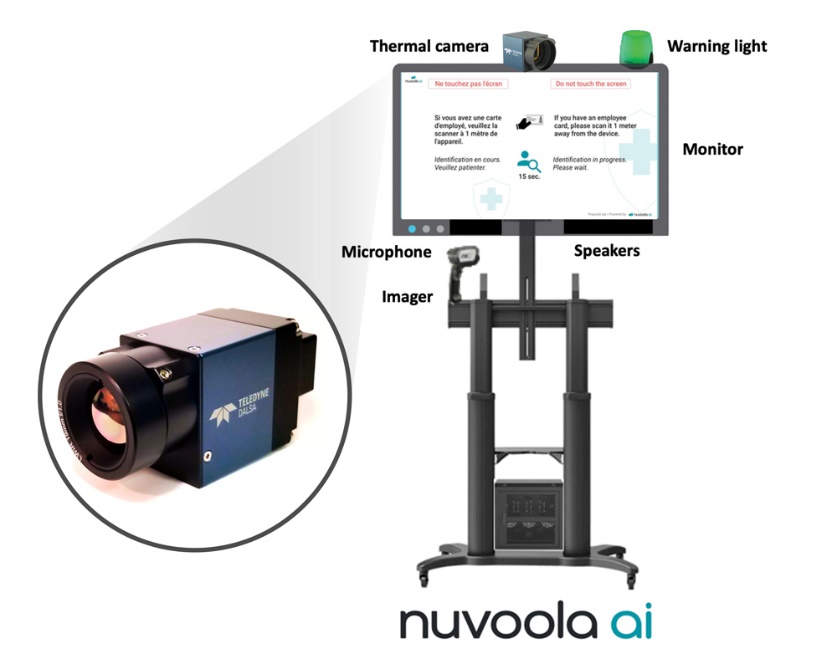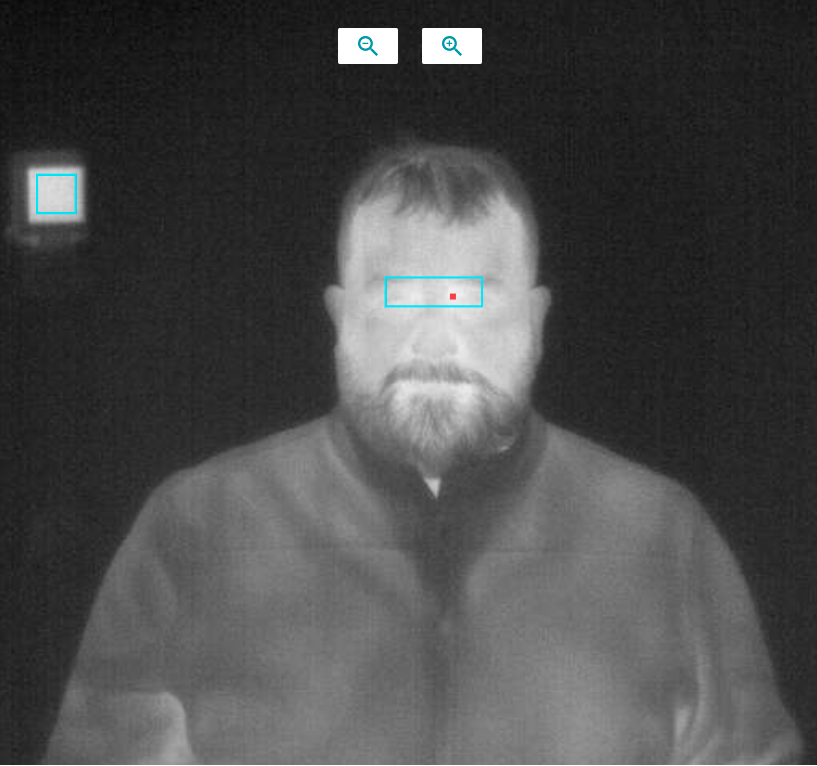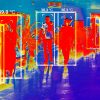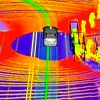Nuvoola: Better Infrared Fever Screening for the Greater Good
Rapid, accurate thermal scanning solution allows for more safety at stadiums, healthcare facilities, factories, and industrial plants.
You’re standing outside your favorite arena. Before you can enter, you steer your forehead toward a technician holding an infrared thermometer. The technician nearly brushes your forehead to take your temperature, which puts her a foot or less from where you’re standing, and although you’re both wearing masks, that short distance makes you feel uncomfortable. What’s more, you know that handheld thermometer scanners aren’t terribly accurate. A sweaty brow, cosmetics, sunlight, certain medications, circulation issues and previous injuries can all reduce accuracy. Moreover, people’s skin absorbs radiation differently, which can further erode accuracy. And accuracy matters a great deal now that temperature-screening has been established as one of the few ways to assess the presence of an active infection of COVID-19. Fortunately, artificial intelligence (AI) firm Nuvoola now offers a much safer and more accurate touchless COVID-19 screening platform for healthcare facilities, factories, and industrial plants.
Nuvoola’s LUKE AI for Health Screening & Protection (HSP) is an AI platform that integrates a display, Teledyne Imaging’s Calibir GX infrared camera, and an ID scanner into a touchless device used for COVID-19 screening. Today, LUKE AI is already deployed in some of New Brunswick’s senior residences—among the population that first inspired Nuvoola President Martin Renière to use his company’s technology to help mitigate the pandemic.
“The devastating loss of life in Canada’s senior residences, especially during those early months of the pandemic, made me realize that I wanted to do something for the population that’s most vulnerable to COVID-19: our elders,” said Renière. “We quickly pulled together a team to develop a screening platform that was more accurate, safer, and more intelligent than any other solution on the market. And that’s what we’ve done with LUKE AI. It’s the most effective solution to digitize, centralize and automate the COVID-19 screening process without human intervention.”
A new approach with artificial intelligence
In stark contrast to the technician with the handheld infrared scanner, the LUKE AI screening experience is self-guided. In a senior home, factory, hospital or other facility with a recognizable pool of residents or employees, LUKE AI guides each person through the screening process.
In a workplace setting, the LUKE AI experience begins before a person even approaches a facility. Employees and visitors complete a pre-screening questionnaire before arrival. When they arrive onsite, the touchless kiosk confirms their answers and measures their temperature to ensure that there’s no fever or other symptoms. If no pre-screening questionnaire was completed, the voice-interactive kiosk, which uses speech recognition and natural language processing to ask a series of screening questions in English or French, takes an accurate temperature reading. The kiosk also uses facial recognition to determine mask-wearing. When the questionnaire indicates no risk and no fever is detected, the kiosk light turns green, and the employee or visitor is granted access to the site. If a fever or other symptom is detected, an alert is triggered, and the kiosk light turns red. At that point, the employee or visitor is instructed to see a nurse or other onsite personnel, or to call a remote operations center for further screening and validation.
Starting the screening process with LUKE AI is as easy as standing two meters away from the LUKE AI kiosk and answering questions. The whole screening process is completely touchless—as is the temperature reading—and it’s fast. LUKE AI can screen recognized personnel within 20 seconds. Individual screening takes about a minute for those who aren’t yet in the system.
While other companies offer only disparate pieces of LUKE AI’s end-to-end platform, none comes close to LUKE AI’s integrated array of features or its accuracy in temperature reading, which is within .1 degree Celsius. Competitive platforms may be off by multiple degrees—which is unacceptable when accuracy is vital to risk reduction.
More Intelligence, Greater Insight
We’re all familiar with the adage: Does a falling tree make a sound if no one hears it? Performing COVID-19 screening using either a handheld infrared thermometer or a touchless platform without analytics is like that tree. The important data that’s gathered, like the sound of the falling tree, resides in isolation. Those who pass their screening may enter the building but there’s no way of knowing how many people passed or failed within a specific time slice, and there’s no mechanism for informing supervisors if there’s a surge in symptoms that requires other precautionary measures, like shutting down the site.

“It’s not just gathering the data that matters, it’s what you do with it,” said Renière. “The intelligence we’ve built into LUKE AI allows the platform to analyze the data collected by the hardware so we can improve safety at the facility.”
LUKE AI is much more than an onsite detection platform. Through a dynamic, centralized dashboard on a smartphone or computer screen, LUKE AI provides real-time monitoring with a single view of a facility’s entire organization. Imagine you’re managing four distribution centers. Using the real-time dashboard for LUKE AI on your phone, you can see that two hundred people at all locations went through the screening process before the first shift of the day. In three out of four facilities, all employees passed screening, but in the fourth, you’ve been receiving real-time alerts telling you that three employees have registered fevers. With that information in hand, you might decide to close that fourth facility until all first-shift employees have tested negative for COVID-19 before you can safely reopen. Only LUKE AI provides the kind of multi-site visibility that allows you to assess in real-time risk levels so you can act quickly and mitigate early.
Up to the challenge
To meet the greatest market-need for its platform, the Nuvoola design team specified a distance of two meters (six feet) between the kiosk and the person using the kiosk while delivering a thermal reading that meets the most rigorous safety standards of the International Safety Organization (ISO). It was a challenge to find the right camera but Teledyne’s Calibir GX camera fit the bill, meeting the stringent ISO IEC 806012-59 safety standard for medical electrical equipment.

“We chose Teledyne’s Calibir because it’s a Canadian-made industrial thermal camera that provides high resolution—which is a requirement for ISO compliance,” said Renière. “At a distance of two meters, Calibir delivers a remarkable pixel resolution of 640 by 480 pixels, the finest resolution of all infrared cameras in this class. Many competitive platforms, on the other hand, offer a resolution of just 240 by 180 pixels, which can’t come close to Calibir’s precision.”
With great sensitivity and precision, outstanding dynamic range for wide temperature coverage, and factory-calibrated radiometric performance, Calibir GX delivers the accurate, repeatable temperature data required for effective, reliable thermal detection.
Beyond pure specifications, Renière said his design team chose Calibir for its quality, performance, and field-proven track record. He also appreciated Teledyne’s collaborative approach to hardware design, which enabled his design team to work closely with the engineers in the Teledyne lab.
Location, Location, Location
When it comes to using infrared for thermal detection, it’s not just the camera’s resolution that matters. It’s the place on the human body where the temperature is scanned—which isn’t on the forehead, as it turns out.

According to many different clinical studies and standards published by the International Electrotechnical Commission (IEC) and the Center for Disease Control and Prevention (CDC), as well as by the ISO, the best place to measure a person´s body temperature for fever detection is the lacrimal caruncle area of the eye, which is the inner part of the eye closest to the tear ducts. LUKE AI instructs each person screened to directly face the thermal camera. It then scans the lacrimal caruncle of the eye and converts the signal of each pixel to receive absolute temperature measurements. Since the threshold between healthy and feverish is very slim, LUKE AI’s precise temperature measurement is critical.
Beyond COVID-19
While Nuvoola initially rolled out LUKE AI to senior residences in Canada, that’s just the beginning. The company could easily deploy their platform to hospitals to ensure that people who are about to receive COVID-19 vaccines aren’t symptomatic. Because it’s an intelligent solution that can interact with people through different channels—email, chatbot, text message, or phone—LUKE AI can even inform people when they need their booster vaccine. That’s a life-enhancing reminder if ever there was one.
LUKE AI holds great potential beyond health applications. Renière sees significant opportunity in adapting LUKE AI for safety screening and security-related purposes.
“We’ve identified numerous needs for self-serve check-in and self-serve operations for customers who want to move away from their traditional walk-in-and-wait model to a self-serve-by-design approach that leverages our kiosk technology,” he said. “Easily configurable for any type of application utilizing questionnaires, outcome instructions, and notifications, just imagine how much more convenient LUKE AI could make it for people traveling through an airport or a train station, renewing their driver license, or checking into a hotel.”
Offering the industry’s most intelligent high-precision touchless screening platform for COVID-19 risk assessment, Nuvoola’s LUKE AI shows us how human innovation can help us more safely engage in daily life, as we navigate the most serious global health crisis of the past one-hundred years.



 Taking some heat: Thermal imaging for elevated body temperature in 2020
Taking some heat: Thermal imaging for elevated body temperature in 2020  Avoiding bumps on the road: how thermal imaging can improve the safety of autonomous vehicles
Avoiding bumps on the road: how thermal imaging can improve the safety of autonomous vehicles 